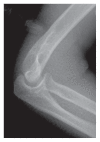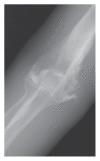Successful Closed Reduction of a Lateral Elbow Dislocation
- PMID: 28097029
- PMCID: PMC5209600
- DOI: 10.1155/2016/5934281
Successful Closed Reduction of a Lateral Elbow Dislocation
Abstract
In this report, we present a case of lateral elbow dislocation treated with closed reduction. Lateral elbow dislocation is rare, and a closed reduction is reported with even less frequency. The reduction can be hindered by swelling and soft tissue interposition, and we describe the use of a nonoperative reduction technique performed under mild sedation with early physiotherapy to avoid joint stiffness. No additional complication was observed, and the normal range of elbow movement and function was obtained by early physiotherapy.
Conflict of interest statement
The authors declare there is no conflict of interests.
Figures








Similar articles
-
Successful closed manipulation of a pure lateral traumatic dislocation of the elbow joint using a modified Stimson's technique: a case report.J Med Case Rep. 2008 May 22;2:170. doi: 10.1186/1752-1947-2-170. J Med Case Rep. 2008. PMID: 18498622 Free PMC article.
-
Successful Closed Manipulation of Simple Lateral Dislocation of the Elbow Joint: A Case Report.Oman Med J. 2013 Nov;28(6):e062. doi: 10.5001/omj.2013.131. Oman Med J. 2013. PMID: 31011404 Free PMC article.
-
Bilateral Elbow Dislocation After Trauma in a Healthy Adult Female.Cureus. 2022 Jan 8;14(1):e21029. doi: 10.7759/cureus.21029. eCollection 2022 Jan. Cureus. 2022. PMID: 35154998 Free PMC article.
-
Transverse divergent dislocation of the elbow with ipsilateral distal radius fracture in a child.J Orthop Trauma. 2007 Feb;21(2):145-9. doi: 10.1097/BOT.0b013e318032c4be. J Orthop Trauma. 2007. PMID: 17304072 Review.
-
A case report of children's divergent dislocation of the elbow and review of literature.Medicine (Baltimore). 2016 Nov;95(44):e4772. doi: 10.1097/MD.0000000000004772. Medicine (Baltimore). 2016. PMID: 27858838 Free PMC article. Review.
Cited by
-
Lateral dislocation of the elbow joint in children: a case report.JSES Int. 2021 Aug 17;5(6):1129-1131. doi: 10.1016/j.jseint.2021.06.009. eCollection 2021 Nov. JSES Int. 2021. PMID: 34766095 Free PMC article. No abstract available.
-
Open postero-lateral dislocation of the left elbow secondary to assault: A case report.Int J Surg Case Rep. 2022 Dec;101:107798. doi: 10.1016/j.ijscr.2022.107798. Epub 2022 Nov 23. Int J Surg Case Rep. 2022. PMID: 36434868 Free PMC article.
-
Upper limb pediatric fractures in 22 tertiary children's hospitals, China: a multicenter epidemiological investigation and economic factor analysis of 32,832 hospitalized children.J Orthop Surg Res. 2022 Jun 3;17(1):300. doi: 10.1186/s13018-022-03159-5. J Orthop Surg Res. 2022. PMID: 35658921 Free PMC article.
References
-
- Chhaparwal M., Aroojis A., Divekar M., Kulkarni S., Vaidya S. V. Irreducible lateral dislocation of the elbow. Journal of Postgraduate Medicine. 1997;43(1):19–20. - PubMed
Publication types
LinkOut - more resources
Full Text Sources
Other Literature Sources

